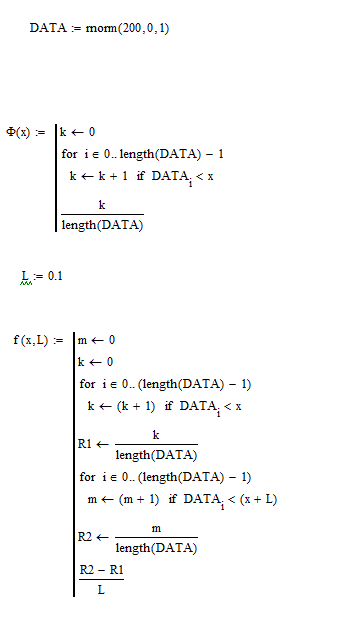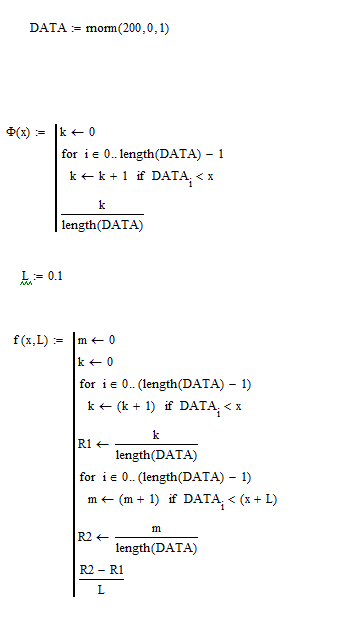Community Tip - You can change your system assigned username to something more personal in your community settings. X
- Subscribe to RSS Feed
- Mark Topic as New
- Mark Topic as Read
- Float this Topic for Current User
- Bookmark
- Subscribe
- Mute
- Printer Friendly Page
Could anyone explain what is going on here? :)
- Mark as New
- Bookmark
- Subscribe
- Mute
- Subscribe to RSS Feed
- Permalink
- Notify Moderator
- Labels:
-
Other
- Tags:
- distribution
- normal
Accepted Solutions
- Mark as New
- Bookmark
- Subscribe
- Mute
- Subscribe to RSS Feed
- Permalink
- Notify Moderator
Ivan Karachinsky wrote:
I understand this is normal distribution density function but need to figure out what the variables stand for exactly. M, L, K, R1 and R2
The normally generated numbers are just there to generate some data for testing - you could equally well replace rnorm with runif or any other distribution.
The function Phi calculates the cumulative distribution for the data, that is the number of values less than x. The function f computes the difference in the cumulative distribution between x and x+L. If you make L small enough, then f approximates to the probability density at x.
As for the variables, ...
m is the count of all values of data < x+L
k is the count of all values of data < x
L is the interval over which to compute the difference in cumulative distribution
R1 is k normalized to the total number of points
R2 is m normalized to the total number of points
I'm a little surprised that f is written like that given the existence of Phi, as the whole thing could have been written as (Phi(x+L)-Phi(x))/L
Stuart
- Mark as New
- Bookmark
- Subscribe
- Mute
- Subscribe to RSS Feed
- Permalink
- Notify Moderator
Where is "here"? I can't see anything in your post.
Stuart
- Mark as New
- Bookmark
- Subscribe
- Mute
- Subscribe to RSS Feed
- Permalink
- Notify Moderator

- Mark as New
- Bookmark
- Subscribe
- Mute
- Subscribe to RSS Feed
- Permalink
- Notify Moderator
I understand this is normal distribution density function but need to figure out what the variables stand for exactly. M, L, K, R1 and R2
- Mark as New
- Bookmark
- Subscribe
- Mute
- Subscribe to RSS Feed
- Permalink
- Notify Moderator
Ivan Karachinsky wrote:
I understand this is normal distribution density function but need to figure out what the variables stand for exactly. M, L, K, R1 and R2
The normally generated numbers are just there to generate some data for testing - you could equally well replace rnorm with runif or any other distribution.
The function Phi calculates the cumulative distribution for the data, that is the number of values less than x. The function f computes the difference in the cumulative distribution between x and x+L. If you make L small enough, then f approximates to the probability density at x.
As for the variables, ...
m is the count of all values of data < x+L
k is the count of all values of data < x
L is the interval over which to compute the difference in cumulative distribution
R1 is k normalized to the total number of points
R2 is m normalized to the total number of points
I'm a little surprised that f is written like that given the existence of Phi, as the whole thing could have been written as (Phi(x+L)-Phi(x))/L
Stuart
- Mark as New
- Bookmark
- Subscribe
- Mute
- Subscribe to RSS Feed
- Permalink
- Notify Moderator
Thank you very much, Stuart!
- Mark as New
- Bookmark
- Subscribe
- Mute
- Subscribe to RSS Feed
- Permalink
- Notify Moderator
Не за что, Ива́н.






